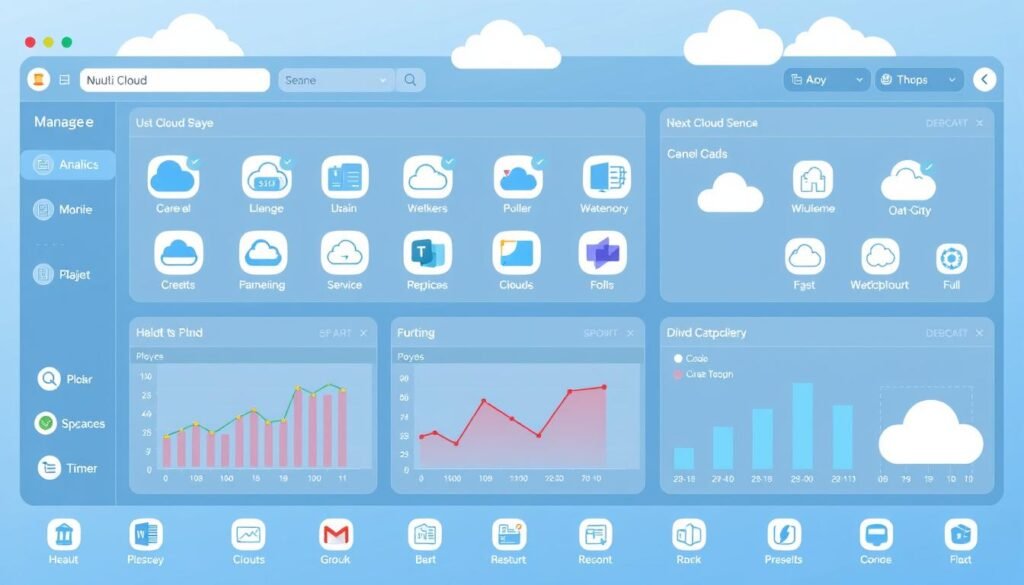Almost 90% of enterprises are projected to adopt a hybrid cloud strategy by 2025, as they seek to balance the need for innovation with maintaining control over critical data and applications.
This shift is driven by the need for flexibility in managing diverse workloads across different environments, including public cloud services and private infrastructure.
As you navigate digital transformation initiatives, a well-planned cloud strategy can provide the agility to modernize at your own pace while maintaining compliance with industry regulations and ensuring robust security measures.
Key Takeaways
- Hybrid cloud strategies offer a balanced approach to innovation and control.
- Combining public cloud services with private infrastructure enhances flexibility.
- Standardized security policies are crucial across all environments.
- A well-planned strategy ensures compliance with industry regulations.
- Effective hybrid cloud adoption requires careful planning and management.
Understanding Hybrid Cloud Environments
Hybrid cloud environments represent a critical component in today’s IT infrastructure, offering a balanced approach to managing diverse business needs. A hybrid cloud is a type of cloud computing that combines a private cloud (on-premises infrastructure) with a public cloud (computing services offered by third-party providers over the public internet). This integration allows data and applications to move seamlessly between the two cloud environments.
Defining Hybrid Cloud Architecture
Hybrid cloud architecture represents the integration of private cloud infrastructure (on-premises or hosted) with public cloud services, creating a unified computing environment. This architecture enables workloads and data to move between private and public clouds efficiently.
Key Components of Hybrid Cloud Infrastructure
The key components of hybrid cloud infrastructure include private cloud resources (data centers, servers, storage), public cloud services, networking capabilities for secure connectivity, and orchestration tools that enable workload management across environments. Effective connectivity solutions like dedicated connections, VPNs, or software-defined networking are crucial for secure and reliable communication between environments.
Differences Between Hybrid Cloud and Multi-Cloud
While often confused, hybrid cloud and multi-cloud represent distinct approaches. Hybrid cloud specifically combines private and public environments, whereas multi-cloud refers to using multiple public cloud providers, regardless of whether a private cloud is involved. Understanding these differences is essential for designing solutions that effectively balance security, performance, and cost considerations.
As the hybrid cloud model continues to evolve, it is incorporating edge computing capabilities, bringing cloud processing power closer to where data is generated. This reduces latency and supports real-time applications, making it a vital strategy for businesses with diverse IT needs.
Benefits of Adopting a Hybrid Cloud Strategy
Hybrid cloud adoption can significantly enhance an organization’s ability to respond to changing business demands while ensuring the security and integrity of critical data. By running certain workloads in the cloud, your organization gains the flexibility and innovation the public cloud provides, while retaining highly sensitive data in your own datacenter to meet client needs or remain in compliance with regulatory requirements.
Enhanced Flexibility and Scalability
Adopting a hybrid cloud strategy provides organizations with enhanced flexibility to scale resources dynamically, allowing you to respond quickly to changing business demands without overprovisioning on-premises infrastructure. This flexibility enables you to scale computing resources while modernizing and protecting mission-critical applications and data.
Cost Optimization Opportunities
Cost optimization is a significant benefit, as hybrid cloud approaches enable you to leverage pay-as-you-go pricing models for variable workloads while maintaining fixed costs for predictable workloads. This results in more efficient resource utilization and reduced capital expenditures.
Improved Business Continuity and Disaster Recovery
Business continuity and disaster recovery capabilities are substantially improved through hybrid cloud adoption. You can replicate critical data and applications across multiple environments, reducing single points of failure and ensuring business continuity.
Regulatory Compliance and Data Sovereignty
Regulatory compliance and data sovereignty requirements can be more easily addressed with hybrid cloud. You can keep sensitive data on-premises or in specific geographic regions while still leveraging cloud capabilities for processing, ensuring compliance with regulatory requirements.
By adopting a hybrid cloud strategy, organizations can achieve better performance by placing workloads in optimal environments, keeping latency-sensitive applications close to users while moving compute-intensive processes to scalable cloud resources. This approach also enables innovation by providing access to advanced cloud services and technologies without requiring a complete migration of all workloads.
Assessing Your Organization’s Hybrid Cloud Readiness
As you consider implementing a hybrid cloud strategy, it’s crucial to assess your organization’s readiness for this complex environment. This involves a thorough evaluation of your current infrastructure, applications, and operational processes to determine their compatibility with cloud environments.
Evaluating Current Infrastructure and Applications
Begin by conducting an inventory of your existing applications and classifying them based on characteristics such as business criticality, data sensitivity, performance requirements, and dependencies. This helps identify suitable candidates for cloud migration. You should also assess your current infrastructure to determine its readiness for integration with cloud services.
Identifying Workload Placement Criteria
Developing clear workload placement criteria is essential. Establish a framework that determines which applications should remain on-premises and which can benefit from public cloud deployment based on factors like security, compliance, performance, and cost. This framework will guide your decision-making process and ensure that workloads are placed in the most appropriate environment.

Determining Security and Compliance Requirements
Carefully assess your security and compliance requirements, including regulatory obligations, data sovereignty constraints, and industry-specific standards. These factors will significantly influence your hybrid cloud architecture and ensure that it meets all necessary compliance standards.
Conducting a Comprehensive Risk Assessment
A comprehensive risk assessment is critical to identify potential vulnerabilities, threats, and impacts across your proposed hybrid environment. This assessment will help you develop appropriate mitigation strategies before implementation, ensuring a smoother transition to the hybrid cloud.
By following these steps, you can ensure that your organization is adequately prepared for a hybrid cloud environment, minimizing potential risks and maximizing the benefits of this flexible and scalable infrastructure.
Implementing Effective Hybrid Cloud Integration

The success of a hybrid cloud deployment largely depends on the effectiveness of its integration, which enables seamless interactions between different cloud environments and on-premises infrastructure. To achieve this, you need to focus on several key areas.
Connectivity and Networking
Establishing secure and reliable connectivity between your on-premises infrastructure and cloud environments is the foundation of effective hybrid cloud integration. You can achieve this through dedicated connections, VPNs, or software-defined networking solutions. Strong hybrid cloud networking is critical for a hybrid cloud deployment to function correctly, leveraging technologies like local area network (LAN), wide area network (WAN), virtual private network (VPN), and application programming interfaces (APIs).
Data Management
Data integration and management strategies are crucial for hybrid cloud success. You need to implement consistent data governance policies, synchronization mechanisms, and access controls across all environments to maintain data integrity and security. This ensures that your data is accurate, up-to-date, and protected, regardless of where it’s stored.
Application Portability
Application portability can be significantly enhanced through containerization technologies like Docker and orchestration platforms like Kubernetes. These tools allow you to package applications with their dependencies and deploy them consistently across different environments, improving flexibility and reducing the risk of compatibility issues.
API and Service Integration
API management becomes essential in hybrid cloud architectures as it enables standardized communication between services regardless of where they’re hosted. This facilitates seamless integration between on-premises and cloud-based applications. Implementing a service mesh can also help you manage service-to-service communications within your hybrid environment, providing features like load balancing, service discovery, and traffic management across platforms.
To further enhance your hybrid cloud integration, consider implementing identity and access management across environments to ensure consistent authentication and authorization. Monitoring and management tools should also be implemented to provide visibility across the entire hybrid infrastructure. Additionally, infrastructure as code (IaC) practices can help automate the provisioning and configuration of resources, ensuring consistency and reducing manual errors.
Balancing Security Across Hybrid Cloud Environments
Hybrid cloud environments present unique security challenges that require a comprehensive and integrated approach. As you deploy resources across multiple cloud platforms and on-premises infrastructure, ensuring consistent security measures becomes increasingly complex.
To address these challenges, you need to standardize your security policies and protocols across all environments. This involves establishing a unified security framework that eliminates gaps and inconsistencies, making it harder for attackers to exploit vulnerabilities.
Standardizing Security Policies and Protocols
Standardizing security policies is crucial for maintaining a robust security posture across your hybrid cloud. You should implement consistent authentication mechanisms, access controls, and incident response plans that apply uniformly across all platforms.
Identity and Access Management Best Practices
Implementing robust identity and access management (IAM) is fundamental to securing your hybrid cloud environment. You should establish centralized authentication mechanisms, role-based access controls, and least privilege principles that apply consistently across your entire hybrid infrastructure.

Data Encryption and Protection Strategies
Data protection is another critical aspect of hybrid cloud security. You should prioritize encryption of data both at rest and in transit, carefully manage encryption keys, and implement data loss prevention (DLP) tools to safeguard sensitive information regardless of where it resides.
Continuous Monitoring and Threat Detection
To ensure the security of your hybrid cloud environment, you need to implement continuous security monitoring and threat detection capabilities. This involves deploying integrated security information and event management (SIEM) solutions that provide visibility into potential security incidents across all platforms.
By implementing these measures, you can significantly enhance the security of your hybrid cloud environment and protect your organization’s digital assets.
- Implement network security controls, including segmentation, firewalls, and intrusion detection/prevention systems, to protect data as it moves between on-premises and cloud environments.
- Address compliance requirements through automated policy enforcement and regular auditing across all environments.
- Consider implementing a zero-trust security model that verifies every access request regardless of source or destination.
Managing Multi-Cloud Environments Effectively
With 98% of cloud computing organizations having adopted multi-cloud infrastructures, the need for effective management tools is more pressing than ever.

Managing multi-cloud environments is a complex task that requires a comprehensive approach. It involves utilizing centralized management and monitoring tools that provide a unified view of resources, costs, and performance across all cloud providers and on-premises infrastructure.
Centralized Management and Monitoring Tools
Cloud management platforms (CMPs) play a crucial role in standardizing operations across diverse environments. They enable consistent governance, automation, and resource provisioning regardless of the underlying platform.
Resource Allocation and Optimization
Resource allocation and optimization become more complex in multi-cloud scenarios. You need tools that can analyze utilization patterns and recommend adjustments to ensure resources are appropriately sized and efficiently used across all environments.
Cost Management Across Cloud Providers
Cost management is particularly challenging when working with multiple cloud providers. Specialized tools can aggregate billing data, identify cost optimization opportunities, and provide accurate forecasting across your entire cloud portfolio.
Performance Monitoring and Service Level Agreements
Performance monitoring must span all environments to ensure applications meet service level agreements (SLAs). Unified dashboards can correlate metrics across platforms and identify potential bottlenecks or issues.
To effectively manage your multi-cloud environment, consider implementing consistent tagging and resource organization strategies across all cloud providers. This helps with governance, cost allocation, and resource management. Automation is also critical as it standardizes operations and reduces the complexity of managing diverse environments.
Establishing a cloud center of excellence (CCoE) within your organization can help develop best practices, provide training, and ensure consistent approaches to multi-cloud management. Regular optimization reviews should evaluate your multi-cloud environment holistically to identify opportunities for consolidation, standardization, or architectural improvements.
Overcoming Common Hybrid Cloud Challenges
As you navigate the complexities of hybrid cloud adoption, you’ll inevitably encounter several challenges that require strategic planning and innovative solutions. Hybrid cloud environments offer numerous benefits, but they also present unique obstacles that organizations must address to maximize their potential.
Addressing Skill Gaps and Training Requirements
Implementing hybrid cloud strategies often reveals skill gaps within IT teams, requiring comprehensive training programs and potentially new hiring strategies to build expertise in both traditional infrastructure and cloud technologies. You need to assess your current team’s capabilities and identify areas where additional training or new talent is required.
Managing Vendor Lock-in Concerns
Vendor lock-in concerns can be mitigated by designing for portability where possible, using container technologies, implementing abstraction layers, and maintaining awareness of proprietary services that may create dependencies on specific cloud providers. This approach allows you to leverage the best features of multiple cloud services while minimizing the risk of being tied to a single vendor.
Ensuring Consistent Performance and Reliability
Ensuring consistent performance and reliability across hybrid environments requires careful architecture design, robust monitoring solutions, and clear service level objectives that account for the different characteristics of on-premises and cloud infrastructures. You must also consider the potential impact of network latency and bandwidth limitations on your applications.
Navigating Complex Compliance Landscapes
Navigating complex compliance landscapes becomes more challenging in hybrid scenarios, necessitating a unified governance approach that can adapt to evolving regulations while maintaining consistent controls across all environments. This includes ensuring that your data management practices meet the necessary compliance standards and mitigate potential risk.
Conclusion: Building a Sustainable Hybrid Cloud Strategy
To maximize the potential ofhybrid cloud solutions, you must prioritize a strategic approach that aligns with your business objectives. This involves creating a versatile setup that can adapt to your specific business needs, allowing you tomigrate and manage workloadsbetween various cloud environments effectively.
A sustainablehybrid cloud strategyrequires ongoing evaluation and refinement as your business needs evolve and technology capabilities advance. It’s crucial that yourcloud strategyaligns closely with your business objectives, ensuring that yourinfrastructuredecisions support organizational goals.
To achieve long-term success, you should develop clear metrics for measuring the success of yourhybrid cloudinitiatives, including cost savings, performance improvements, and security enhancements. Additionally, building governance frameworks that can adapt to changing regulatory requirements is essential.
Byfuture-proofing your hybrid cloud strategy, designing for flexibility, and maintaining awareness of emerging trends, you can drive innovation and stay competitive. Continuous skills development within your IT teams and partnerships with trusted advisors will also help you sustainhybrid cloud operationsand improve efficiency.
Ultimately, a well-executedhybrid cloud strategyprovides the foundation for digital transformation, enabling your organization to innovate faster and deliver enhanced experiences to customers and employees.



